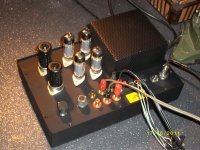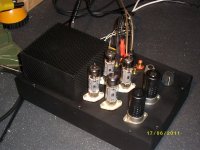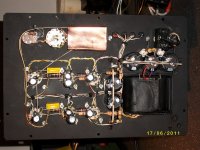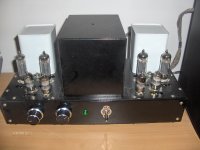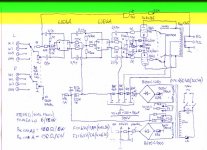there is an interesting otl circuit in the phillips datasheet for this tube, just wondering if anyone has built it or has worked with this tube?
As Tweeker said.
That circuit was there for a while using Philips 600 ohm loudspeakers as counter-performance to the "vicious" uquibitious output transformer of the day. As I recall, it did not stay for long - the loudspeakers did not 'make it'.
As for EL86, they are rather similar to the EL84, but not so sensitive (needing a somewhat higher g1 drive voltage). They had a higher maximum plate voltage (600V), and was mainly employed in voltage regulators of the day. Unless there is economical advantage, I would stay with EL84 in normal circuits.
(To answer your question, I did occasionally use them.)
That circuit was there for a while using Philips 600 ohm loudspeakers as counter-performance to the "vicious" uquibitious output transformer of the day. As I recall, it did not stay for long - the loudspeakers did not 'make it'.
As for EL86, they are rather similar to the EL84, but not so sensitive (needing a somewhat higher g1 drive voltage). They had a higher maximum plate voltage (600V), and was mainly employed in voltage regulators of the day. Unless there is economical advantage, I would stay with EL84 in normal circuits.
(To answer your question, I did occasionally use them.)
Hi Tweeker,
Actually, the nominal load for that circuit as spec´d is 1k.
Regards,
Tom Schlangen
Tweeker said:Be aware this OTL is for 600ohm speakers IIRC.
Actually, the nominal load for that circuit as spec´d is 1k.
Regards,
Tom Schlangen
Hi mctavish,
Actually both. Be prepared not to get anyway near the Po as stated in the spec sheet. Besides that, EL86/6CW6 or PL84/15CW5 are very nice pass regulator tubes 😉 There are quite some circuits out there using it in HiFi apps (and instrumental amplification, too) if you really look for them.
BTW, you can get the triode-strapped curves here. Also, don´t miss the General Electric spec sheet recommendations if you are heading for sheer Po (20W and up from a pair).
Regards,
Tom Schlangen
mctavish said:there is an interesting otl circuit in the phillips datasheet for this tube, just wondering if anyone has built it or has worked with this tube?
Actually both. Be prepared not to get anyway near the Po as stated in the spec sheet. Besides that, EL86/6CW6 or PL84/15CW5 are very nice pass regulator tubes 😉 There are quite some circuits out there using it in HiFi apps (and instrumental amplification, too) if you really look for them.
BTW, you can get the triode-strapped curves here. Also, don´t miss the General Electric spec sheet recommendations if you are heading for sheer Po (20W and up from a pair).
Regards,
Tom Schlangen
I have several 6CW5 tubes and have used them in a few designs. Beware that they are NOT interchangeable with the 6BQ5 / EL84 even though the pinout is the same.
In my books (GE, RCA) the 6CW5 carries a 250 volt maximum plate voltage. The screen grid is rated for 200 volts. These can be violated a little, but plugging one into an EL84 amp will cause a bright red glow, for a short unhappy time.
I have used them in a Simple P-P board. They like 3000 to 3500 ohm plate to plate load with about 275 to 320 volts of B+ MAX! That is cathode biased so the tube sees 260 to 300 volts. Any more than that and the death glow comes on quickly. Some tubes don't even like that much. Given these limitations I can still get 15+ watts out of a pair.
The 6CW5 will work well on lower B+ voltages (150 to 200 volts) where the EL84 goes limp. This makes them good for hybrid amps with the output tube and a BIG mosfet are wired together in "darlington" configuration.
They had a higher maximum plate voltage (600V),
In my books (GE, RCA) the 6CW5 carries a 250 volt maximum plate voltage. The screen grid is rated for 200 volts. These can be violated a little, but plugging one into an EL84 amp will cause a bright red glow, for a short unhappy time.
I have used them in a Simple P-P board. They like 3000 to 3500 ohm plate to plate load with about 275 to 320 volts of B+ MAX! That is cathode biased so the tube sees 260 to 300 volts. Any more than that and the death glow comes on quickly. Some tubes don't even like that much. Given these limitations I can still get 15+ watts out of a pair.
The 6CW5 will work well on lower B+ voltages (150 to 200 volts) where the EL84 goes limp. This makes them good for hybrid amps with the output tube and a BIG mosfet are wired together in "darlington" configuration.
Hello ,
Klein + Hummel used the EL86 in their TS 60 amps , with ECF 80 as driver tube .
I rebuild one of these amps many , many years ago and used him every day .
Regards , Alexander .
Klein + Hummel used the EL86 in their TS 60 amps , with ECF 80 as driver tube .
I rebuild one of these amps many , many years ago and used him every day .
Regards , Alexander .
An externally hosted image should be here but it was not working when we last tested it.
Not to belabour; the 1970 RCA Tube Manual sometimes show different voltages for max. plate voltage and plate supply voltage, sometimes the same. The latter is where I got the 600V from (former = 275V there). But nowhere do they say what exactly plate supply voltage is supposed to mean.
Also not to hi-jack the thread, but perhaps someone here can elucidate on the difference for everybody's benefit.
Also not to hi-jack the thread, but perhaps someone here can elucidate on the difference for everybody's benefit.
Phillips and Mullard EL86 give limit values of 250V anode, 550V anode cutoff.
Tung Sol 6CW5 also gives limit values as maximum plate voltage 250V,
maximum plate voltage without plate current 550V.
I'm guessing this is what RCA's 275V and 600V are getting at.
Tung Sol 6CW5 also gives limit values as maximum plate voltage 250V,
maximum plate voltage without plate current 550V.
I'm guessing this is what RCA's 275V and 600V are getting at.
thanks for the posts guys. think i will try this circuit over the
weekend and see how it goes. i was really interested in using it
with some hi-q fullrange speakers, hoping that the output
impedance wouldnt be too big an issue. ive heard of those 600
ohm phillips speakers, and i wonder what their construction was
like...
weekend and see how it goes. i was really interested in using it
with some hi-q fullrange speakers, hoping that the output
impedance wouldnt be too big an issue. ive heard of those 600
ohm phillips speakers, and i wonder what their construction was
like...
With an 8ohm load you'd be lucky to make .1W @ 10% THD.
SRPP amps depend on the load for their phase splitting, expect 2nd harmonic distortion.
SRPP amps depend on the load for their phase splitting, expect 2nd harmonic distortion.
What about a Circlotron (with OPT) ?
http://www.dissident-audio.com/AutoIndex/index.php?dir=Circlo_EL86/
Yves.
http://www.dissident-audio.com/AutoIndex/index.php?dir=Circlo_EL86/
Yves.
600 ohm
Hallo guys!
I make this amp with ECC88, 2XEL803 per channel, with some modifications for working point.
Of course, I made boxes with ellipsoidal, full range speakers 5W 600 Ohm, especially
for this purpose. Amplifier have very flat frequency response and low distortion, smooth and
warm tone. I use schematic for some old Phillips black&white TV set.
Hallo guys!
I make this amp with ECC88, 2XEL803 per channel, with some modifications for working point.
Of course, I made boxes with ellipsoidal, full range speakers 5W 600 Ohm, especially
for this purpose. Amplifier have very flat frequency response and low distortion, smooth and
warm tone. I use schematic for some old Phillips black&white TV set.
Attachments
EL86/PL84 were intended for lower voltage/higher current circuits than EL84 or circuits where the available voltage was shared between two series valves. Hence a lower max anode voltage can coincide with a higher max supply voltage.
As a company which made both valves and loudspeaker drive units, Philips was in a good position to help them match in impedance terms, by developing lowish impedance valves and highish impedance speakers. Maybe they had developed a clever method for winding high impedance voice coils? The idea never really caught on.
As a company which made both valves and loudspeaker drive units, Philips was in a good position to help them match in impedance terms, by developing lowish impedance valves and highish impedance speakers. Maybe they had developed a clever method for winding high impedance voice coils? The idea never really caught on.
EL86(6CW5) works very well in guitar amp. at Ua~350-380V with fixed bias, but UG2 must be under 200V in this case. Output power was over 25W (Push-Pull classAB, Ua=370V, UG2=185V, UG1~-18-20V, Ia0=25mA) with OT impedance Raa~4kOhm, with THD~4%. Also work perfect in small HI-FI amp (2x6W, Push-Pull ClassA/AB, Triode conected with Raa~3,5kOhm, and Ua-k~230-240V) over 5years with 6CW5(EL86) from "EI-Nis"-manufacturer.
Last edited:
hey-Hey!!!,
I am currently using EL86 in a balanced output linestage. LTP with 20k plate loads, and a 37 mA CCS on the tail. B+ is 485. Performance similar to 12B4 with slightly more gain and less microphonics. It is driving a Rane AC22b active cross over.
cheers,
Douglas
I am currently using EL86 in a balanced output linestage. LTP with 20k plate loads, and a 37 mA CCS on the tail. B+ is 485. Performance similar to 12B4 with slightly more gain and less microphonics. It is driving a Rane AC22b active cross over.
cheers,
Douglas
That Philips topology was used in some of the famous Carlsson Speakers, The coalbox and OA6-1(bi-amped 1 amp for 10" bas and 1 amp for 8"mid and tweeter).
The tweeters had a small opt so it was never totally OTL.
OA6-1 is a very good sounding setup.
Have some of those old philips 9710AM hiding in the storage.
The tweeters had a small opt so it was never totally OTL.
OA6-1 is a very good sounding setup.
Have some of those old philips 9710AM hiding in the storage.
I did use the Philips EL86 many years ago (1961-65) for the PPS 245 as from "Alta Fedeltà" (issue n° 3 of 1961 page 75-81 schematic of Fig.10 page 81) which you can look at http://www.introni.it/pdf/Alta Fedelta 1961_03.pdf
The driver used is the 9710AM (800 ohm), for detailed specs see Philips 9710M/01 Fullrange Loudspeaker Measurements Data and Information Full Range
It's a vintage product and it still works
The driver used is the 9710AM (800 ohm), for detailed specs see Philips 9710M/01 Fullrange Loudspeaker Measurements Data and Information Full Range
It's a vintage product and it still works
Take a look at Hammond organ AO-44. A wonderful simple amp design. Also Scott stereo integrated Type 200. I've run AO-44s for stereo and was happy. Ripped out the reverb section and compression crap, went straight to the tube and left it stock. They can be had for a song. That's my audio secret....
- Home
- Amplifiers
- Tubes / Valves
- anyone ever use EL86/6CW5?
